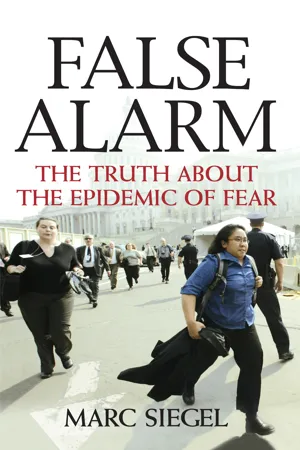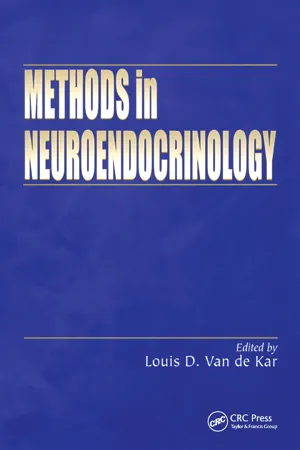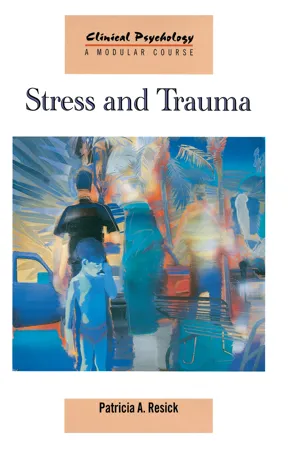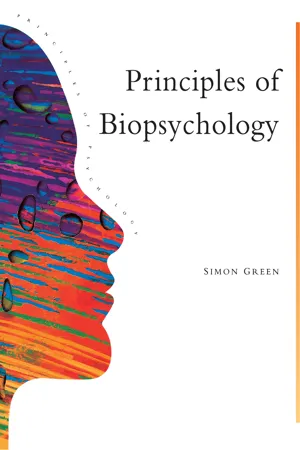Psychology
Fight-or-Flight Response
The fight-or-flight response is a physiological reaction that occurs in response to a perceived harmful event, attack, or threat to survival. It is a natural survival mechanism that prepares the body to either confront the stressor or flee from it. This response involves the release of stress hormones, increased heart rate, heightened senses, and redirection of blood flow to major muscle groups.
Written by Perlego with AI-assistance
Related key terms
12 Key excerpts on "Fight-or-Flight Response"
- eBook - ePub
- Elizabeth Watts(Author)
- 2019(Publication Date)
- CRC Press(Publisher)
Part I Fight or FlightOxford Dictionary:fight or flight: The instinctive physiological response to a threatening situation, which readies one either to resist forcibly or to run away.Wikipedia:The Fight-or-Flight Response (also called hyperarousal, or the acute stress response) is a physiological reaction that occurs in response to a perceived harmful event, attack, or threat to survival. It was first described by Walter Bradford Cannon. His theory states that animals react to threats with a general discharge of the sympathetic nervous system, preparing the animal for fighting or fleeing.Passage contains an image
Chapter 1
Religion Meets Science
Abstracts
Religion has played a major role in American culture since the first colonists arrived over 500 years ago. The earliest settlers brought with them the idea of creating a Christian nation and this idea has been passed down through hundreds of years of American history. This chapter examines how societal, political and cultural developments in the 1800s stirred up a new emotional element of American religiosity that was characterized by a close and personal relationship with God. As the history of the nation continued, religiosity became coupled with political activism. By the 20th century, there was a major focus on organizing evangelical activity to create political change and this grassroots activism soon focused on creating policy changes that would influence how evolution was taught in American public schools.A recent question on ‘Research Gate’ caught my attention. One researcher asked, “Is it possible me to be a scientist and still maintain my religious views and belief in God?” The question received a myriad of answers, often contradictory. The answer to the question seemed simple enough to me. I grew up in a predominantly Catholic community on the border to Mexico, where many of my teachers and professors at university as well as my own mom were simultaneously scientists as well as devote Catholics. But this compatibility between religious beliefs and scientific careers is not so self-evident for many individuals who adhere to more fundamentalist belief systems. Here I will examine this general question to see what conflict, if any, exists between religion and science and whether this conflict is inherent or artificially constructed. Is it possible for religion to co-exist with science? Does an individual have to choose between their God and their interest in science? In this Section I will discuss the current research in these areas and offer insights by comparing various religions stance on evolution and take a specific look at the differences between traditional mainline Christianity and evangelical Christianity to determine how these differences affect adherents’ ability to understand and accept scientific tenets. - eBook - ePub
- Paul McGreevy, Janne Winther Christensen, Uta König von Borstel, Andrew McLean(Authors)
- 2018(Publication Date)
- Wiley-Blackwell(Publisher)
Figure 13.1 The standard stress model. When the brain perceives a stressor, two main sets of physiological reactions prepare the body for bursts of exercise (‘fight or flight’) and activate a range of other reactions (e.g. reduced pain perception and immunological responses).The central nervous system assesses whether a stimulus represents a significant challenge to the animal. If it is perceived as threatening (i.e. a stressor), the biological defence consists of a combination of behavioural, autonomic and neuroendocrine stress reactions, and the individual is in a state of stress. The body’s immediate physiological reaction to a stressor is characterised by activation of the sympathetic system, which prepares the body for action. The fight or flight reaction of the sympathetic system is initiated by stimulation of the hypothalamus, which transmits signals via the reticular formation in the brain stem to the spinal cord to cause sympathetic discharge. This immediately results in several physiological changes, which lead to a greater physical and mental ability, so that the animal can perform more strenuous physical activity than would otherwise be possible (Korte, 2001). Sympathetic stimulation increases both the rate and force of the heart’s contractions, as well as arterial blood pressure. Blood flow is redirected, with the blood vessels constricting to supply less blood to non‐critical areas (e.g. the gut, which inhibits digestion) and more blood is directed to the skeletal muscles and the brain. The transmitter at the neuromuscular junction is noradrenaline, a close relative of adrenaline. These hormones and neurotransmitters prepare the body for bursts of physical exercise, for example, when about to flee from a threat (Sapolsky, 2002; 2004).The sympathetic system is counteracted and modulated by the parasympathetic system, where the actions are principally opposite to those of the sympathetic system. The parasympathetic system becomes active when the body is engaged in processes relating to general body maintenance, such as eating and ingesting food. It slows the heart and respiration rates, and stimulates digestion and growth. The normal state of rest is predominantly characterised by parasympathetic activity. In stressful situations, the parasympathetic activity decreases in favour of a higher sympathetic activity, enabling the animal to react appropriately (e.g. with flight). - eBook - ePub
Foundation Focus Freedom
The THREE STEP PROCESS for Transforming Your Mindset, Overcoming Your Fears and Harnessing Unimaginable Success
- M.D. Terence Young(Author)
- 2018(Publication Date)
- Young Phoenix Enterprises, LLC(Publisher)
This was first discovered and recognized by Walter Cannon, an American physiologist of Harvard University. He first presented his findings and theories in his book, “The Wisdom of the Body,” published in 1932.Without going into the technical details of physiology, with a focus more on the overall concept of the response, it was essential for protecting our early ancestors. In simplistic terms, the fight or flight response enhances a multitude of stress hormones within our physiology, which can cause a physical body response that can include several factors:Dilating the pupils and enhancing your visual acuity. Increasing your heart rate and blood pressure as well as your breath rate. Enhancing your mental focus, awareness and alertness. Decreasing your perception of discomfort and pain. Diminished blood flow to the frontal cortex of the brain which can control logical and rational thought and actions. So why would this be important in our early human development?Think about it. When we were in our evolutionary stage, we had to rely on hunting game for our basic needs, while at the same time being the hunted.When we were threatened by animals that could seriously maim or kill us, we had to have a response that was built in; an automatic order to enhance our survival. Thus, an event which caused us stress, fear, or worry, would automatically trigger this response system, essentially putting us in a heightened state and protective mode.At the time, this was necessary for survival, and understand this, it is still very necessary today. However, the number of stimuli that trigger this response is multiplied on a massive magnitude. - eBook - ePub
The Body Bears the Burden
Trauma, Dissociation, and Disease
- Robert Scaer(Author)
- 2014(Publication Date)
- Routledge(Publisher)
The immediate effects of the arousal neurotransmitter norepinephrine on the brain include increased alertness and focus, immediate enhancement of short-term memory, dilatated pupils, increased muscle tone, and divergence (outward movement) of the eyes to expand the field of view. The immediate effects of body-based epinephrine and brain-based norepinephrine prepare the organism for the high-level neuromuscular activity required for ensuring survival in the face of threat—the fight/flight response. These effects promote short-term preparation of the brain for intense alertness, and the neuromuscular and cardiovascular systems for high-level short-term skeletal muscle and cardiac activity and energy expenditure. Activation of the fight/flight response, of course, may be triggered by excitement as well as by threat.FIGURE 2.2 Hypothalamic/pituitary/adrenal axis. Sensory input signaling stress or threat (see Figure 2.1 ) activates the hypothalamus, triggering release of corticotropin-releasing hormone (CRH) and arginine vasopressin (AVP). These promote release of cortisol from the adrenal medulla. Cortisol inhibits further release of ACTH, modulates the basic noradrenergic arousal response, and mediates the long-term stress adaptation response to stress.The basic physiological sympathetic nervous system response of the prey in response to threat is mirrored by that of the predator as it prepares for attack. Pre-game jitters, stage fright, sexual arousal, and the thrill of the roller coaster ride all reflect the physical sensations associated with arousal in the face of threat. What separates the experience of the fight/flight response from that of anticipatory excitement, of course, is the meaning of the event to the participant. This piece of information processing takes place in the hippocampus (comparison of new information with past associative memories), and the orbitofrontal cortex (problem solving and planning).4 - eBook - ePub
False Alarm
The Truth about the Epidemic of Fear
- Marc Siegel(Author)
- 2008(Publication Date)
- Trade Paper Press(Publisher)
Fear is more than a state of mind; it’s chemical. It is present in the circuitry of our brains, in the neurochemical exchanges between nerves. Fear is a physical reaction to a perceived threat. As long as the danger is direct and real, fear is normal and helps to protect us.When an individual feels threatened, fear revs up the metabolism in anticipation of an imminent need to defend oneself or flee. “Fight or flight,” or the “acute stress response,” was first described by Walter Cannon, an American physiologist, in the 1920s. Cannon observed that animals, including humans, react to threats with a hormonal discharge of the nervous system. There is an outpouring of vessel-constricting, heart-thumping hormones, including noradrenaline (norepinephrine) and adrenaline (epinephrine), followed by the steroid cortisol. The heart speeds up and pumps harder, the nerves fire more quickly, the skin cools and gets goose bumps, the eyes dilate to see better, and the brain receives a message that it is time to do something.We need to know when another animal is threatening to attack us in order to kill us and eat us. The fact that this particular threat doesn’t exist anymore outside of the darkest jungles doesn’t mean that fear can no longer be useful, as it is when we stand too close to the edge of a building or turn the wrong way down a one-way street. Triggers of fear involve sudden or dramatic changes in our environment, including dark, light, cold, heat, noise, isolation, or irritation. We react by getting ready, either to attack the source of our fear or to move away from it.But not all danger is palpable or immediate. Many of the things that scare us aren’t sudden, surprising, or matters of life or death. Fear has many guises. For every change of life there is a new set of concerns. For every milestone there is a transition, and fear and foreboding are normal aspects of making these transitions. They are the body’s way of cautioning us that the change may or may not be for the better. - eBook - ePub
Body Psychotherapy
Sanando el trauma en el eterno presente del ahora
- Vassilis Christodoulou(Author)
- 2018(Publication Date)
- Hakabooks(Publisher)
CHAPTER 12 THE PHYSIOLOGY OF STRESS: FIGHTING OR FLEEINGA study of the physiology of stress would be incomplete without a brief consideration of how our ancestors dealt with stressful events before the creation of what we call ‘civilisation’, with its challenges and limitations.One thing we share with our ancestors who lived in the jungle is our nervous system. Yet this sensitive system, which enabled our ancestors to perceive danger quickly and prepare themselves to give an instant physical response, instead of saving us in the ‘jungle’ of our modern everyday life, literally kills us.How else could anyone react to the dangers of the jungle apart from fighting or fleeing? In our ancestors’ time danger was always connected with a fear of physical injury or death. We have therefore been endowed with a system for perceiving and reacting to danger which is effective when the danger represents a threat to our existence and can be effectively dealt with either by fighting or fleeing. Today most of the dangers we face do not directly threaten our lives but are of a cultural kind, and have to do with our self-image and ambitions. The response, however, remains the same: either to make a stand or to run away. Yet we cannot fight or flee in the same way that our ancestors did when we are faced by the challenges of modern life, such as taking exams or having to deal with criticism or censure. When danger threatened primitive man, all of his energy had to be directed to his body’s ‘front line’ in order to deal with it. Bodily secretions and physiological changes instantly provided this power, which was expended in the effort to survive, either by fighting or by fleeing: the muscles were tautened, adrenaline and glucose were released, the heart beat faster, blood was pumped from the stomach and the reproductive system to reinforce those organs deployed in the front line of battle, the lungs expanded to take in more oxygen and sweat was exuded, all to bolster the body’s defences – a reaction that primitive man would in no way have recognised as ‘stress’ in the way we understand it. - eBook - ePub
Health Inequality
An Introduction to Concepts, Theories and Methods
- Mel Bartley(Author)
- 2016(Publication Date)
- Polity(Publisher)
In most of the psycho-social literature, the focus is on how feelings which arise because of inequality, domination or subordination may directly affect biological processes. In various guises, this kind of explanation for social inequality in health has been a pervasive influence on health inequality research. Rather than emphasizing physical hazards, or behaviour alone, the psycho-social model focuses on the way social inequality makes people feel, and how these feelings may themselves alter body chemistry.The biology of stress: fight, flight and defeat
The original ideas behind this line of research were based on the existence of two types of response to external threats shared by both humans and other animals (Brunner 1997). The most well-known of these is the so-called ‘fight-or-flight’ response. The body receives alarm messages from the brain that can be thought of as activating one or other of two ‘response circuits’: the sympathetic-adrenomedullary and the hypothalamic-pituitary-adrenocortical axis. Both of these circuits involve the adrenal gland (hence ‘adrenaline’), which sits close to the kidney. The adrenomedullary circuit involves a structure within the adrenal medulla, one of the inner layers of the gland, whereas the cortical circuit involves the outer layer or cortex.It is the sympathetic-adrenomedullary circuit that is perhaps nearer to popular ideas of the Fight-or-Flight Response. This reaction involves the sympathetic nervous system, which, in balance with the parasympathetic nervous system, is responsible for much of what goes on in a routine and subconscious way in the body. They govern how fast the heart is beating, responses to changes in outside temperature (shivering, sweating) and the pH (acidity) level of the blood, for example. Sympathetic nervous stimulation releases adrenaline from the adrenal medulla, and at the same time the ends of the sympathetic nerves themselves release noradrenaline. This prompts the release into the bloodstream of fibrinogen, a substance that helps blood to clot more easily. At the same time, the heart rate and blood pressure rise, and the small blood vessels (capillaries) nearest to the skin narrow sharply. This prevents excessive blood loss from a wound, but it also has the effect of raising blood pressure. - eBook - ePub
- Louis D. Van de Kar(Author)
- 2020(Publication Date)
- CRC Press(Publisher)
Chapter 10 Neuroendocrinology of Stress: Behavioral and Neurobiological Considerations Béla G. J. BohusContents
I. Introduction II. The Neuroendocrine Stress Response A. Methodological Issues B. Selection of the Stressor: A Behavioral View C. The Primary Neuroendocrine Stress Response D. The Conditioned Stress Response III. The Functional Architecture of the Neuroendocrine Stress Response IV. Concluding Remarks References I. Introduction
The stress reaction is a common feature of all living beings. Within the animal kingdom including humans, perception of all changes in the external or internal environments elicits a chain of physiological reactions that can be construed as adaptive to the organism. Cannon1 was the first to study physiological responses to directly threatening environmental stimuli. The “fight or flight” response as natural reaction to threat is characterized by the activation of the sympatho-adrenal system and the inhibition of the parasympathetic limb of the autonomic nervous system. A sympathetic mass discharge was considered to be responsible for diverse signs of stress such as tachycardia, blood pressure rise, hyperthermia, piloerection, etc. These observations can be considered as roots of stress physiology and pathology. The concept of non-specificity of bodily responses designated as stress to diverse noxious stimuli (stressors) was introduced in the mid nineteen thirties by Hans Selye.2 Selye’s stress theory emphasized the prominence of the adrenal cortical hormone response to stressors. This hormonal response serves to alert the organism to external and internal environmental changes and to preserve homeostasis. Selye’s adrenal-oriented concept led stress research to become the domain of (neuro)endocrinologists, a sole domain for the first almost 30 years. The concept was then shared by endocrinologist and psychologists, but a monodisciplinary character was preserved within both disciplines for the next three decades. The emergence of the stress and coping theories in psychology, as developed from the mid nineteen sixties, led to the introduction of the behavioral dimension in the complexity of stress responses.3 Another emergence in the same period, the foundation of psychoneuroendocrinology, a specialization to amalgamate normal and pathological brain function with the endocrine interieur milieu, resulted in at least a couple of novel developments. First, it was recognized that hormone levels in the circulating blood provide a window into the brain by reflecting emotional and mental states.4 Studies in laboratory animals, particularly of rodents and primates, and in humans, substantiated this view by showing the involvement of limbic and cortical extra-hypothalamic structures in the regulation of the neuroendocrine system.5 Second, it emphasized that the brain is the major target of peripheral hormones, and, perhaps more importantly, the nervous system is also a major source of endocrine principles, long regarded as classical hormones.6 - No longer available |Learn more
- Patricia A. Resick(Author)
- 2014(Publication Date)
- Psychology Press(Publisher)
In the twentieth century, one of the most prominent influences in the study of stress was the work of Hans Selye (1956/1976). Selye proposed a "general adaptation syndrome" in response to stress, which included three stages: alarm and mobilization, resistance, and exhaustion. The alarm stage is the initial reaction to a stressor and may last up to a few hours. In this stage the stress hormones are mobilized. In the resistance stage, response systems are activated to return the body to homeostasis. The resistance stage may last for days or weeks. However, if the stressor is prolonged or repeated, then the exhaustion stage sets in, having important implications for physical and psychological health. The autonomic nervous system (ANS) and the endocrine system are implicated most broadly in the first stage as the person undergoing acute stress experiences a fight-flight reaction. Although the ANS continues to be involved in the next two stages, these later stages are heavily influenced by the neuroendocrine system. Selye did not focus on particular stressors or distinguish between normative and traumatic stressors. Rather, his focus was more on the universal nature of the stress response and how continued stress would sap a person's adaptational energy. As research has focused more on the most serious stressors, it is clear that even if the stressor is of a very brief duration, if it is perceived as severe, then chronic and perhaps permanent changes in biology may occur.In the face of an acute stressor, the person who is exposed to the stressor experiences a strong autonomic nervous system reaction to face the emergency. This sympathetic reaction, first called a "fight or fight" response by Cannon (1914), is intended to be a short-term protective reaction to move blood into the major muscle groups for motor response, rapidly increase energy supply to the muscles by mobilizing blood glucose, increase heart rate and respiration, constrict the blood vessels in the skin to limit blood loss, and stop unnecessary biological processes during the emergency. In order to accomplish these tasks, important hormones are activated.When exposed to stress, the brain responds with a cascade of neurochemicals intended to respond to the threat. Among them, epinephrine (adrenaline) and norepinephrine (noradrenaline) play a major role. These hormones, the catecholamines, act to increase heart rate, blood pressure, respiration, oxygen consumption, and blood sugar. Epinephrine and norepinephrine are secreted by the adrenal glands, the locus coeruleus, and by sympathetic nerve fibers and are received by adrenergic receptors. The coordinated response between these hormones and nerves allow the proper emergency reaction to maximize a fight or flight response. Norepinephrine is associated with the "flight response" and result in hypervigilance, autonomic arousal, fear, and exaggerated startle (Davis, Suris, Lambert, Heimberg, & Petty, 1997). - eBook - ePub
Coward
Why We Get Anxious & What We Can Do About It
- Tim Clare(Author)
- 2022(Publication Date)
- Canongate Books(Publisher)
I’d tried to change my diet before. I’d met up with friends to do workouts. The new routine only ever lasted a few weeks before something got in the way. Feeling like I’d earned a break, I’d return to old vices with the frenzied abandon of a just-bathed spaniel rolling in fox shit. If I didn’t eat every couple of hours, I’d struggle to concentrate. My anxiety would spike. I’d stammer. My hands would become shaky. It became so bad my doctor sent me for a blood test to see if I was prediabetic. The test came back negative, but it was a wake-up call.I couldn’t go on with this cycle of peaks and crashes. But how was I supposed to magically attain the iron discipline to overhaul my diet and start exercising? I needed an expert. After a couple of emails, I headed to London to meet Dave Thomas, co-founder of the Foundry gym and a personal trainer with over 20,000 hours of training sessions under his belt.—‘From a biochemical perspective, nothing has changed for our bodies from when we were hunter-gatherers.’ I met Dave at his gym in London, and we got talking about Cannon’s fight, flight or freeze response. Once, it helped us survive bears, wolves and sabre-toothed tigers – but we don’t have those any more. ‘What we do have is fucking annoying co-workers, we have stressful commutes, we have fast food, we have constant caffeine.’In the face of these psychological, physiological and dietary stressors, our bodies react as if we’re facing a physical threat. The stressful commute doesn’t even need to happen – just the anticipation that it might is enough to trigger the response. One working definition of ‘stress’ within medical and psychological literature is ‘a threat to homeostasis’.The main trigger within the body is the hypothalamus, a cone-shaped structure near the base of your brain.* - eBook - ePub
The Handbook of Stress
Neuropsychological Effects on the Brain
- Cheryl D. Conrad(Author)
- 2011(Publication Date)
- Wiley-Blackwell(Publisher)
A detailed outline of the integration and execution of the various components of the stress response is beyond the scope of this chapter, but what follows is an introduction to the fundamentals of the SNS and HPA axis in relation to stress. At the most basic level, the stress response involves a series of SNS and endocrine responses that aim to restore stability within the body and promote the ability of an organism to deal with a threat. A critical feature of these systems is to mobilize energy resources for instant use while simultaneously inhibiting body functions that are nonessential for immediate survival. Thus, heart rate, blood pressure, and blood glucose levels are elevated while digestive and reproductive processes are curtailed. Inflammation is reduced and pain perception is blunted. The immune response is immediately activated to promote defense, followed by processes put into place to prevent overshoot and the possibility of autoimmune damage. Components of the central nervous system (CNS) are activated, via neurotransmitter, neuropeptide, and hormonal messengers, to enhance learning and memory processes, and to further regulate maintenance of HPA output. Behavioral changes also occur, with organisms experiencing increased arousal and vigilance in order to identify and appraise threats within the environment.At the core of an acute stress response is the initiation of the Fight-or-Flight Response, which is characterized by its sympathetic-adrenal medullary components that serve as the first response to prepare the body for the energy resources it will require. Upon experiencing a threatening or stressful situation, the SNS is engaged and stimulates rapid release of catecholamine hormones (i.e., epinephrine and norepinephrine [or noradrenaline]) to direct autonomic processes. Norepinephrine is released from postganglionic fibers onto target organs, providing a local release of norepinephrine (see Figure 1.2 - eBook - ePub
- Simon Greene(Author)
- 2013(Publication Date)
- Psychology Press(Publisher)
As I pointed out at the beginning of this chapter, psychology has found emotion an elusive topic to study. Even today there is no agreed definition of the term, and at least 30 current models. Research on the central and peripheral biological mechanisms has clarified some issues, and led to systematic and inventive experiments. We can make some general statements, but detailed psychobiological models will have to wait until we have a psychological analysis of emotional experience and behaviour that we can all accept.Summary: Stress, Anxiety, and Emotion- Stress exists when there is a mismatch between perceived demands and perceived coping ability. It can be energising, but long-term chronic stress can also lead to psychological and physiological problems.
- The adrenal gland plays a central role in the physiological responses to stressors. The adrenal cortex releases corticosteroids in response to the hormone ACTH which is secreted from the pituitary gland. As the pituitary is in turn controlled by the hypothalamus, this chain is known as the hypothalamic-pituitary--adrenal axis.
- In stressful situations the autonomic nervous system (ANS) activates the adrenal medulla, which releases adrenaline and noradrenaline into the bloodstream. General ANS activation and the release of hormones from the adrenal gland produces a pattern of peripheral arousal in the body. If the stressor is short-lasting, the arousal fades away; its basic purpose is to supply the energy needs involved in behavioural coping responses.
- Selye identified the General Adaptation Syndrome. Physiological stress responses go through stages of alarm, resistance, and exhaustion when confronted by chronic stressful situations.
- Coping responses to modern day stressors do not always involve physical activity, and the physiological arousal found in these situations therefore becomes maladaptive and can lead to psychosomatic disorders.
- The work of Brady and Weiss with animals has shown that physical reactions to stressors are influenced by individual differences and by feedback on successful coping behaviour.
- Frankenhaeuser demonstrated that adrenaline release is sensitive to any arousing stimulation. Males show a more vigorous adrenaline release than females in stressful situations, although this may not apply to females in non-sex role stereotyped roles.
Index pages curate the most relevant extracts from our library of academic textbooks. They’ve been created using an in-house natural language model (NLM), each adding context and meaning to key research topics.











